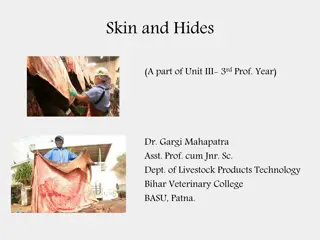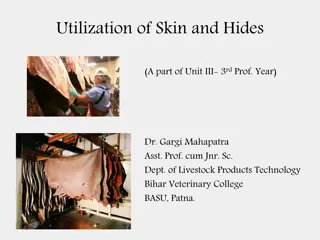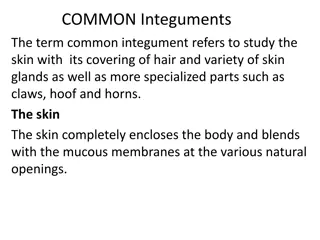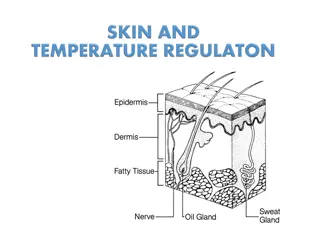The Importance of Skin and Hides in Livestock Industry
Skin and hides are crucial by-products of large and small animals, with differences in thickness and weight. They are sourced from slaughtered and fallen animals, processed through drying, tanning, and conditioning to produce leather. Leather has outstanding strength, flexibility, and weather insula
0 views • 16 slides
Skin and Hides Utilization in Livestock Products Technology
Skin and hides are important by-products obtained from slaughtered and fallen animals, with different characteristics and yields. The process involves flaying to separate the hide from the animal's body, followed by various treatments to produce leather. Leather, with its excellent strength, flexibi
0 views • 29 slides
The Common Integuments and Skin Anatomy
The common integuments encompass the skin, hairs, skin glands, claws, hooves, and horns, playing vital roles in protection, thermoregulation, and drug administration. The skin's structure consists of the epidermis and dermis layers, renewing continuously to maintain its functions. Additionally, nail
0 views • 11 slides
Pressure Ulcers and Tissue Injuries Progression
Pressure ulcers, also known as pressure injuries, are localized damages to the skin and underlying soft tissue usually over bony prominences. The National Pressure Ulcer Advisory Panel changed the terminology in 2016 to classify all stages as injuries, not just ulcers. Stages range from non-blanchab
0 views • 13 slides
Diseases of Skin Overview and Primary Lesions by Dr. Sonam Bhatt, Assistant Professor VMD Basu Patna
Skin, the largest organ of the body, plays a crucial role in regulating temperature and acting as a protective barrier. It consists of the epidermis, dermis, and subcutis, along with skin appendages like hair and claws. Skin lesions can be categorized into primary and secondary, with primary lesions
0 views • 18 slides
Thermoregulation in Animals and Humans
Thermoregulation is the process of regulating body temperature in organisms. It can be seen in two types of animals - ectothermic and endothermic. Ectothermic animals rely on external energy sources to maintain body temperature, while endothermic animals use internal metabolic energy. The skin plays
0 views • 22 slides





